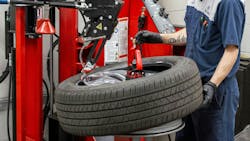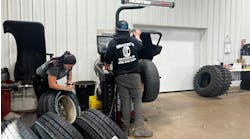Mounting high performance (HP) and ultra-high performance (UHP) tires can be a complex process due to varied tire/wheel sizes, the high risk of wheel and tire damage and other factors. Mistakes can be costly.
Tire mounting machines make the process easier, bringing speed, accuracy and consistency into the equation. But keeping mounting machinery properly maintained does take work.
“A tire machine is the most used and abused piece of equipment inside a tire shop today,” says Kyle Harris, senior project manager at Coats Co. “Shop owners and technicians look to tire mounting equipment to perform duties safely and quickly every workday. A tire machine never gets a day off.”
“Keeping up with tire machine maintenance allows tire shops to keep throughput high and problems non-existent,” says Harris, who adds that components can experience very high wear rates, especially in busy shops, where output is high.
Jim Hudson, product manager for tire changers at Hunter Engineering Co., says “a good analogy is the brakes on a car. Lots of city driving and hard braking wears brake pads faster than the same vehicle being driven all-highway.
“Similarly, extreme service can wear moving, pivoting and sliding parts faster. This leads to undesirable free play, which can lead to operational problems.”
“As a tire machine wears, many of its pieces and parts become loose and unserviceable,” notes Harris. “This means the tire machine is more likely to cause damage. Bead looseners, as well as swing arms and clamping jaws, can all wear and become loose over time, making the machine feel sloppy and imprecise. This is a recipe for damaged wheels and ripped tires.”
What to watch
A single scratch or gouge on a tire may not look alarming to a non-discerning eye, but when it’s on a costly, ultra-high performance tire, this has the potential to cost you in both profits and reputation.
To avoid these types of issues, Dave Wiederschall, BendPak Inc.’s national accounts manager, shares these key tips:
Keep spare demount/mount heads to prevent machine downtime. Demount/mount heads wear over time and without them, tires cannot be changed.
Replace pneumatic cylinder valves as soon as possible. If shop air is uncontaminated and they are regularly lubricated, pneumatic cylinders can last a long time. However, the seals themselves do wear out. Replacement will keep contamination and moisture out of the cylinder body. Seals are cheaper to replace than an entire air cylinder.
Replace the filter regulator lubricator (FRL) regularly. The FRL typically sits on the back of the machine and has few moving parts to wear out. However, the housing can become damaged due to activity around the machine. A tire changing machine should not be operated without the FRL.
Chuck Searles, training manager, equipment, at Snap-on Inc., says that tire changers “are built to endure rigorous use with components such as mount/demount heads and protection covers or slides requiring frequent inspection due to wear.
“Additionally tire changers rely heavily on pneumatic cylinders for their operation. These systems have internal seals that require lubrication. Tire changers should have an air/water separator and lubricator assembly on them that need to be checked and serviced according to the machine’s usage volume.”
Searles recommends weekly inspections to ensure optimal functioning. “Neglecting proper lubrication and air supply can lead to premature equipment failure,” he says.
Hudson says also watch for bent or broken parts, which can damage wheels.
“Regular maintenance of a tire mounting machine ensures that the machine will operate smoothly over a long period of time,” says Weiderschall.
“A tire mounting machine is an important investment for a shop and an important service to customers. If this machine is not working properly, it means lost productivity and lost business.
“In addition, if a tire mounting machine needs repair, it may damage a customer’s wheels or tires, thus causing added replacement expenses and unhappy customers. It is always best to proactively inspect and repair tire mounting machinery before costly issues arise.”
When to replace or repair
Tire mounting machines are built to endure rigorous use and repairing parts is frequently a workable option, but all machines must at some point be replaced to ensure safe operation.
Hunter Engineering’s Hudson says that “machine age is a big factor in the repair versus replace decision.”
“The crucial thing to understand about tire mounting equipment is (the) constant exposure to abuse,” says Snap-on's Searles. “Consequently, it becomes more important to thoroughly check machines over for operational safety and their ability to continue removing or installing tires without unnecessary loss. If expensive components need replacement and the tire mounting machine is older, it may be time to consider replacement.”
Some tire dealers simplify the decision-making process by establishing specific criteria to aid in determining the best course of action.
“This can include the number of repairs made on the machine, cost of the repairs, age, model type, etc.,” says Hudson.
But he emphasizes that determining a course of action does not have to be that scientific. Common sense is equally as valid in making a decision.
“Are you turning away tire service because you cannot service certain assemblies? Are technicians having trouble with certain assemblies because of outdated technology? These are indications that you need new equipment.”
Wiederschall agrees that staying up-to-date is crucial. He suggests dealers invest in new machinery when “a pattern of lost business is beginning to occur as a shop’s current tire mounting machines cannot meet the tire changing criteria of new wheel and tire designs, technologies and customer replacement requests.”
Keeping up with emerging tire technology and trends comes with a lot of advantages for dealers.
“Investing in a new more capable tire machine to pursue a fleet account is a great way to open up new revenue streams," says Harris.
“The decision, of course, has a lot to do with the unit’s overall volume and the shop’s requirements for particular features that the previous unit lacked,” says Searles.
“The market is now full of vehicles with stiffer sidewalls (and even) run-flat tires, as well as low-profile high-performance tires.
“Tire mounting machines without power assist features to help fit these newer sidewall designs means your shop is less productive than the competition. These features can help bring in new business.”
“A tire changer needs to be able to safely service the tires and wheels your customers are bringing to your shop and also the ones you want them to bring to your shop,” says Harris.
And, of course, if a machine is no longer able to safely change modern tires, it should be upgraded, he adds. “Safety is always paramount when discussing shop equipment. If a tire mounting machine can no longer safely change modern tires, it should be updated.”
Some best practices
HP and UHP tires and custom wheels can present challenges when mounting. It’s important to use the right equipment and to ensure your technicians are properly trained to help minimize frustration, keep tires damage free and minimize errors.
“Aside from making sure your equipment is capable, (i.e., lever-less mount head, multiple press arms/rollers, etc.) I would simply recommend that technicians take their time and remember the basics,” say Hunter’s Hudson.
“Things like tire lube and drop center apply to all tire changing jobs. High performance tires and wheels are expensive and taking a little extra time to do things right is a best measure that will absolutely save time and money for your shop in the short and long run — an idea that every tire dealer can get behind.”
“Knowing the correct procedure and using the correct accessories can make changing even the toughest tires quick and easy,” says Coats’ Harris.
“Applying a good paste lube is a great way to keep technicians fast and careful.
“Having two independent pressing devices to push the tire into the drop center when mounting the top bead is a bare minimum these days. A wheel lift is a great way to help lift those heavy, large-diameter custom assemblies and prevent technicians from straining their backs.”
Snap-on's Searles says features “such as integrated bead assist arms play an essential role in helping users keep the tire properly positioned in the center of the rim which is a key part of the process. Ensuring that the tire stays seated within the drop center throughout both removal and installation stages greatly helps with operational efficiency.”
And don’t overlook the role of skilled technicians.
Wiederschall, BendPak’s national accounts manager, says employing tire technicians “who are adept at and current with these new products and operating equipment is a high priority.
“This means having tire technicians who respond well when faced with the latest generations of modern high-performance vehicles with high-end wheels and tires and who understand how to work with the customers who want the latest tire shop services.”



